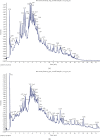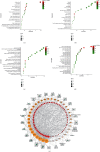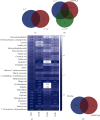UHPLC-Q-TOF-MS/MS and Network Pharmacology Analysis to Reveal Quality Markers of Xinjiang Cydonia oblonga Mill. for Antiatherosclerosis
- PMID: 35669732
- PMCID: PMC9167097
- DOI: 10.1155/2022/4176235
UHPLC-Q-TOF-MS/MS and Network Pharmacology Analysis to Reveal Quality Markers of Xinjiang Cydonia oblonga Mill. for Antiatherosclerosis
Abstract
Cydonia oblonga Mill. (COM), mature fruit of genus Rosaceae, is consumed as a kind of traditional Chinese medicinal herb. Previous studies have shown that the components in COM extract have antioxidant, anti-inflammatory, blood pressure-lowering, blood lipid-lowering, antithrombotic, and other biological activities. However, the quality markers (Q-markers) of atherosclerosis (AS) have not been elucidated. The Q-marker is based on the five core principles of traceability, transferability, specificity, measurability, validity, and prescription dispensing. In this study, the quality markers of quince were investigated by applying the ultraperformance liquid chromatography-time-of-flight mass spectrometry (UHPLC/Q-TOF-MS/MS) method and network pharmacology method to highlight the three core elements which are, respectively, traceability transmission, measurability, and validity. At the first step, 72 components were identified by applying the ultraperformance liquid chromatography-time-of-flight mass spectrometry (UHPLC/Q-TOF-MS/MS) method. In the next step, 46 candidate components of COM anti-AS were obtained by network pharmacology, and then, 27 active components were filtered with the molecular docking assay. Finally, the 27 active components were intersected with 10 active components obtained by mass transfer and traceable quality markers. Four anti-AS Q-markers of COM were identified, including caffeic acid, chlorogenic acid, ellagic acid, and vanillic acid, which provided a reference for the quality control of quince. The methods and strategies can also be applied to other traditional Chinese medicines and their compound preparations, providing new ideas on the quantitative evaluation and identification of quality markers.
Copyright © 2022 Jimilihan Simayi et al.
Conflict of interest statement
The authors declare that there is no conflict of interest regarding the publication of this paper.
Figures









References
MeSH terms
Substances
LinkOut - more resources
Full Text Sources
Research Materials

